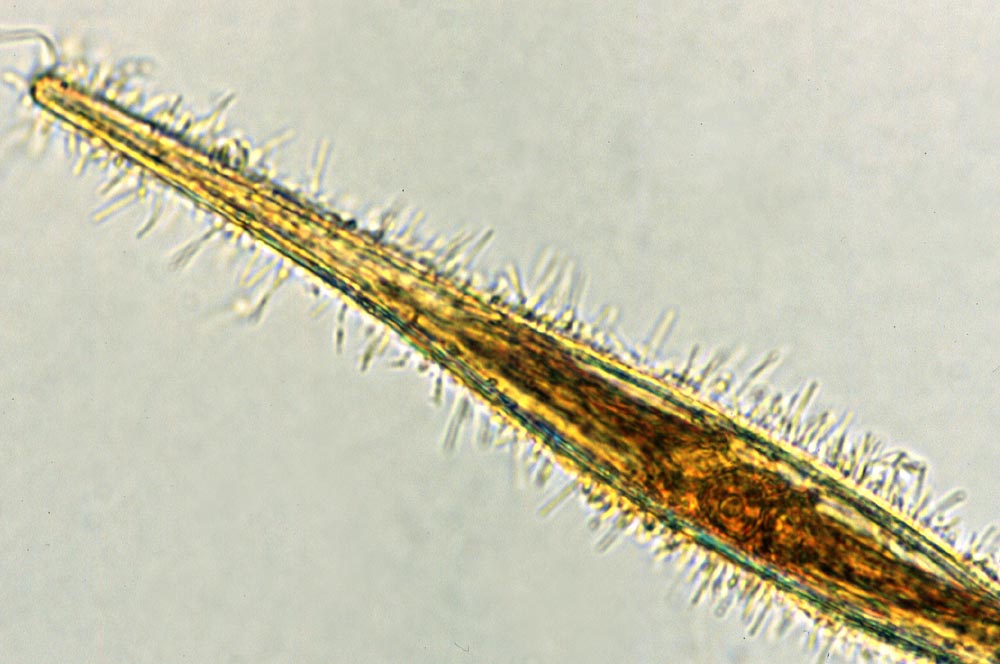Benthic diatoms from the saline-marshes
of Guérande
°°°°°°°°°°°°°°°°°°°°°
The saline-marshes in the Guérande peninsula:
The
Guérande peninsula is located in the southeast of Brittany,
northward of the estuary of Loire. For fifteen centuries, people have
fitted out this zone of swamps situated at the level of the ocean to
produce the sea salt by natural evaporation of the sea water. At the
present time, the surface occupied by the saline-marshes is around 2000 hectares.
From the open sea to the rectangular pools ("oeillets") were the salt crystallizes, the salinity increases progressively until 27%.
The samples :
Nine samples of the surface of the sediment and of the water which covers it (only some cm) were collected on october 2nd 2008, in a
"bondre", in a tidal reservoir, in a neglected tidal reservoir, in several "fares" and in an "oeillet". The salinity was not measured at the different points of collect.
After
dilution with 0.5 volume of sea water, the samples ware shaken deeply
and the diatoms were separated from the sediment by 2 or 3 differential
sedimentations. The
frustules were treated and prepared according to Loir (2004a et
2004b ; Bibliography).
Résults :
None diatom was present in the sample collected in the "oeillet". In the other samples a total of 87 taxa was found (see list of taxa). In each sample, between
15 and 48 taxa were observed.
According to the samples, between 10% (neglected tidal reservoir) and
20% (tidal reservoir) of the taxa were stenohaline marine species.
Between 40%
(tidal reservoir) and 61% ("fare") were euryhaline marine species able
to support, according to the species, a salinity under 30-33 ‰ or an higher salinity. Between
22 and 26% were brackish-water species. Between 0% ("fare") and 13%
(tidal reservoir) were euryhaline freshwater species. Two stenohaline
freshwater species were found in the tidal reservoir.
In the whole of the samples, the genera Nitzschia (14 taxa) and Navicula (13 taxa) were dominant. The genera Amphora, Cocconeis and Gyrosigma were represented respectively by 5, 4 and 5 taxa.
In the sample collected in one "fare", many Nitzschia sigma and Nitzschia rigida cells
diplay fine expansions, often in the shape of small sticks with a
length around some µm. These sticks could be either bacteria or
fungi.
Many marine species and brackish-water species present in the
saline-marshes of Guérande are presented elsewhere in this site
(see Sublittoral zone of Brittany and Eulittoral zone of Brittany). Some other taxa are presented in :
Conclusions :
Because
of the small number of samples and because they have been collected
only once, in autumn, our data are obviously partial and temporary. In
samples obtained in the saline-marshes of Guérande between march
and june 1980, Y. Rincé et J.M. Robert (see Bibliography)
have found 55 species. Only 17 are present among the 87 species that we
have listed. In such environments where the salinity and the
temperature vary strongly, the planktonic and benthic populations
undergo pronounced qualitative and quantitative variations.
During
the Summer, the salinity in the tidal reservoirs is around 4-4.5% and
in the "fares" around 5.5-20%. Likely, at the time of our sampling it
was clearly lower because of previous rains. This could explain the
presence of euryhaline freshwater species.
Three euryhaline species present in the saline-marshes during the Spring and in our samples are remarkable (Rincé & Robert 1980). Gyrosigma balticum and Nitzschia sigma var. sigmatella
are able to support variations of salinity from 0 to 6.1% and 0 to
9.6%, or even 16.8%, respectively (holeuryhaline species), while for Navicula ramosissima the supportable variation of salinity is from 2 to 9.6% (polyhaline species).
